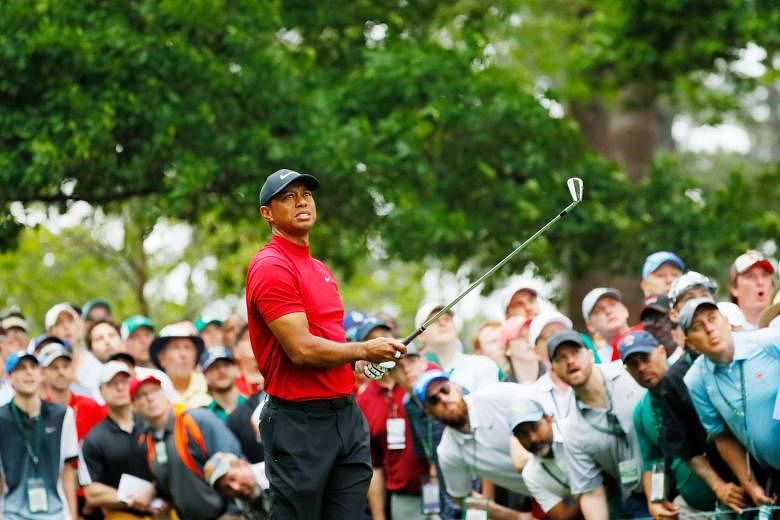NEW YORK • Through Tiger Woods' 11 years in the wilderness between Major wins, professional golf searched for a successor.
Would it be Phil Mickelson, the lefty who is actually older than Woods but who got over the hump in 2004 to become his most formidable early-career challenger?
How about Rory McIlroy, the phenom from Northern Ireland, whose brutal collapse in the final round of the 2011 Masters was immediately followed by his first Major championship? Or maybe Jordan Spieth, whose Masters win in 2015 tied Woods for the 72-hole record?
Ultimately, it ended up being all of them, and therefore none of them. Each had a handful of Major wins and at times looked as if he could dominate the sport.
But none emerged as the next Tiger. Golf itself stagnated as Woods struggled, his shadow looming in a way that was almost as impactful as his presence had been for the previous decade.
Now that Woods is back on top, the question is whether the sport can take advantage of his twilight years to build something that survives when his career finally ends.
Jay Monahan, the commissioner of the PGA Tour, believes the sport is well positioned to capitalise on the re-emergence of Woods.
He pointed to the new schedule, with the PGA Championship held in May, and a long-term, US$2 billion (S$2.71 billion) international television rights agreement with Discovery.
"It's not like you change your business in a moment like this," Monahan said. "You think about how you get to a moment like this and put your tour and product in the best possible position."
By most metrics, golf peaked in the early 2000s, at the height of the first Tigermania.
According to Gallup, in 2000, 5 per cent of Americans surveyed said golf was their favourite sport to watch.
By 2017, that number was 1 per cent. Golf was tied with volleyball, boxing, gymnastics, motocross, figure skating and rodeo.
According to the Sports and Fitness Industry Association, 29.5 million Americans played a round of golf in 2007. In 2017, that number fell 19.3 per cent to 23.8 million.
Unlike most other sports, which believe fans respond most to parity, Woods' dominance was electrifying for golf.
From June 1997 - when he first became the world No. 1 golfer - to October 2010, only four golfers besides him were ranked No. 1, for a total of less than 11/2 years. Woods was ranked first for two different five-year streaks in that time.
Since October 2010, 11 golfers have been ranked No. 1, and only committed golf fans and golfers can name more than a few of them.
The money available to golf professionals, however, continues to grow and, if Woods keeps winning, he will do something few athletes get to: Profit from the explosive growth in revenue that the athlete himself drove.
In professional sports, athletes benefit from the stars of the preceding generation driving interest. Magic Johnson earned less than US$24 million in his entire career; LeBron James earned US$33 million this season.
This year, the top prize at each tournament on the PGA Tour - even the Corales Puntacana Resort and Club Championship - is more than the US$486,000 Woods earned for winning the 1997 Masters. The FedEx Cup bonus pool has doubled to US$70 million.
Tim Derdenger, a professor of marketing and strategy at Carnegie Mellon's business school and a scratch golfer who has written numerous papers on Woods and celebrity endorsements, said the golf world could learn a great deal from how consumers and golfers reacted to Woods.
For someone who at one point was collecting some US$50 million a year in sponsorship deals, Woods had what marketing experts call a "golden halo effect", Derdenger said.
Initially, people wanted to buy products associated with Woods because they aspired to identify with him. Those deals largely went away after Woods' sordid 2009 but, if the halo effect returns, so will the sponsorships.
Derdenger said Woods also provided "informational value" - people believed the apparel and equipment he endorsed were of high quality, as long as he was high in the world rankings.
Woods has a similar effect on the tournaments he enters. When he is competing and on the leaderboard, fans view it as a quality event worthy of their attention.
The television ratings for the Masters last Saturday were the highest for the third round of a tournament since 2015, and Sunday's viewership was solid considering start times were moved up hours to accommodate inclement weather.
Monahan, who took charge of the PGA Tour in 2017, said growing and diversifying golf's fan base were his top priorities.
That is achieved through getting people to try non-traditional versions of golf, like Topgolf and video game golf, and providing viewers myriad options to watch.
It also means getting children to play through the First Tee, a youth development organisation formed in 1997, or Woods' TGR foundation.
Monahan is hopeful Woods' Masters win will be galvanising.
"These moments bring more people into our sport," he said.
NYTIMES

